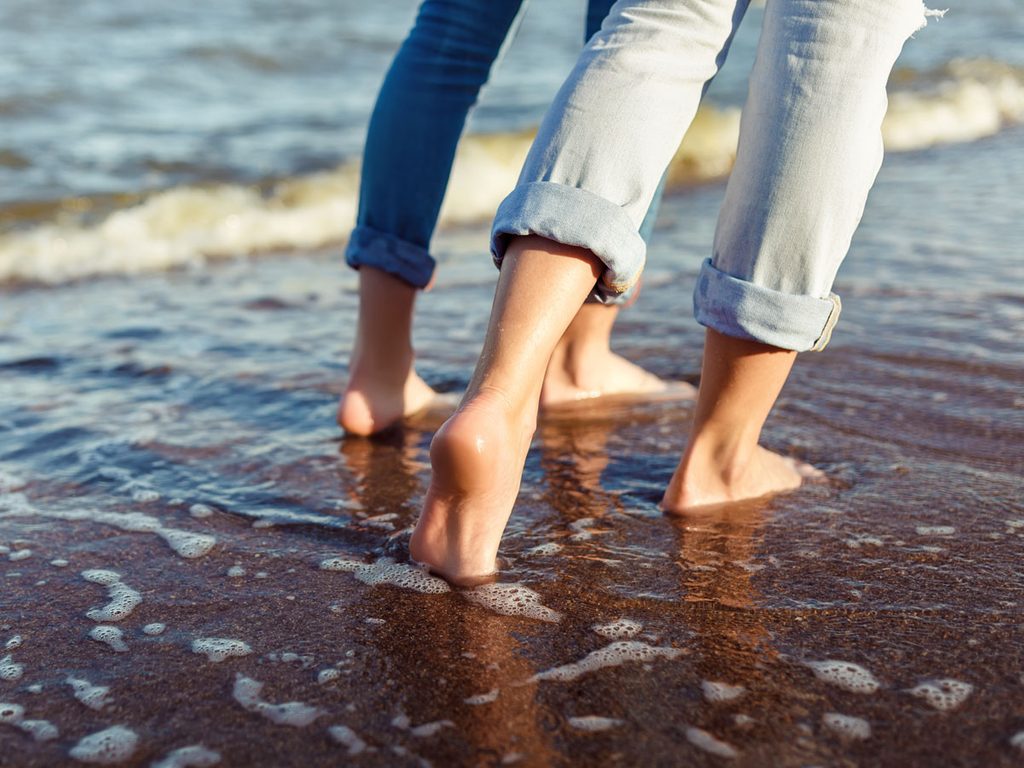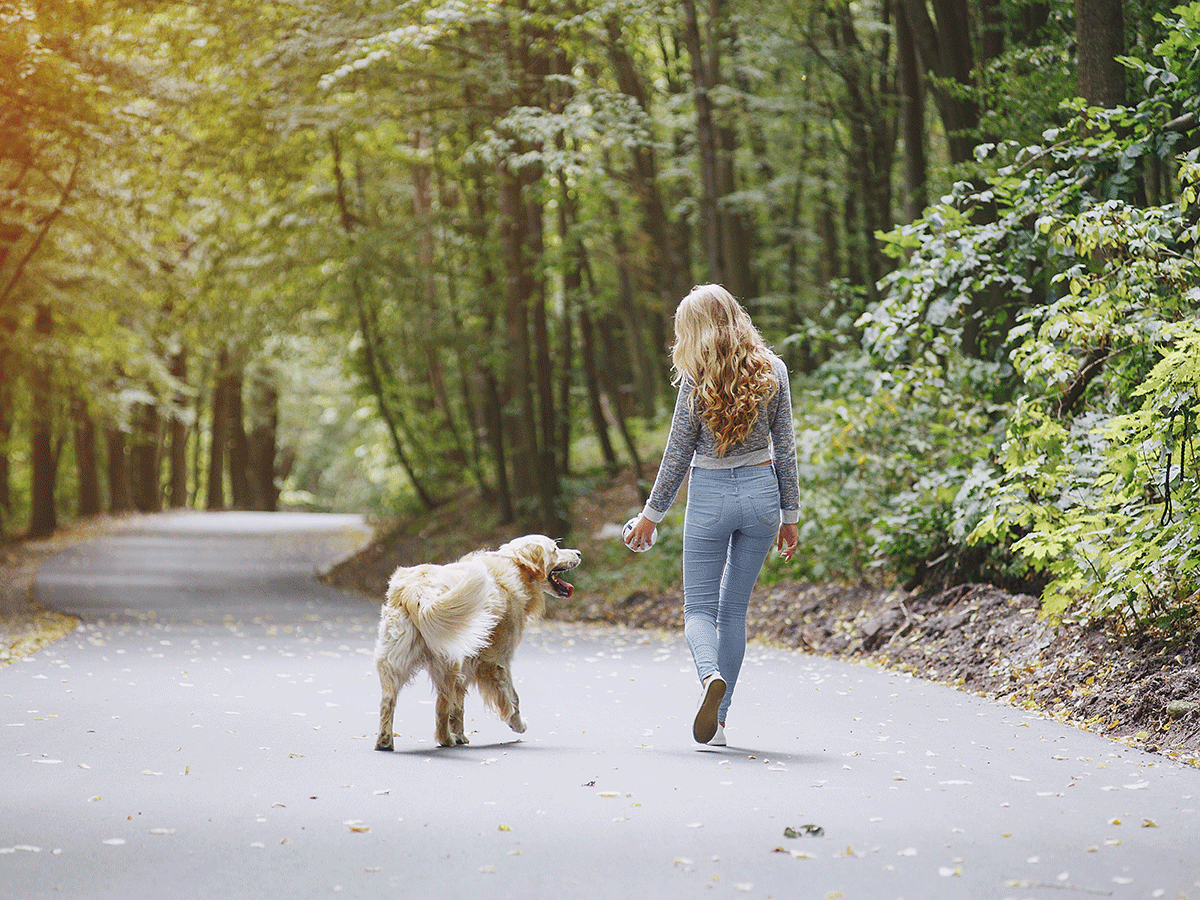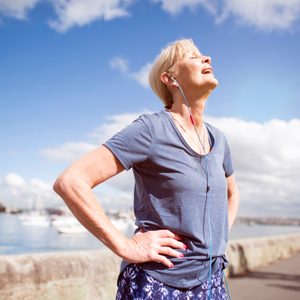Is Walking Barefoot Bad For Your Feet?

An orthopedic surgeon reveals the benefits and potential dangers of walking barefoot, including the risk of infection and foot problems.
Walking around barefoot might be one of the great sensory joys of life, particularly in childhood. What could feel better than running on a grassy lawn or sandy beach, footloose and fancy-free, as they say?
However starting at a young age, most of us avoid walking around barefoot for obvious reasons—you could step on piece of glass, develop an infection, or injure your feet. But, with the coronavirus pandemic, a lot of people are working or going to school at home. That means the daily look probably consists of sweatpants, no shoes, and being barefoot or wearing slippers for most, if not, the entire day.
But, it’s safe to walk or exercise in your own home without socks or shoes on, right? Yes and no—it depends on a variety of factors. Whether or not walking barefoot is bad for your feet depends on where you are walking, whether you’re exercising at the time, and your own personal health conditions and foot anatomy.
Here are the risks and benefits of going barefoot, whether you’re inside your home, outside your home, or at a beach, pool, or gym.
Should you exercise in bare feet?
Do you remember the barefoot running craze? “The premise behind it was that in running with minimalist shoes, one was returning to a more ‘natural gait pattern,’ that would, in theory, lead to a reduction in running-related injuries,” explains Andy Brief, MD, board-certified orthopedic surgeon at Ridgewood Orthopedic Group in Ridgewood, New Jersey. But that didn’t turn out to be the case. In fact, runners and practitioners found that barefoot running could sometimes generate foot injuries like stress fractures, plantar fascia injuries, tendonitis, and more, says Dr. Brief. (Here are some other common running mistakes.)
“In a typical running stride, the point of contact with the ground is situated more towards the heel,” he says. “When running barefoot, the point of contact shifts more towards the mid-foot and forefoot,” which could result in foot issues. Many runners abandoned the practise.
The current research suggests there is not enough evidence that it has benefits over other types of running. For example, a 2016 review published in Revista Española de Podología, looked at various studies on barefoot running and found that it did not provide greater benefits over running with sneakers or minimalist footwear (shoes that have minimal midsole to mimic running barefoot). The researchers also found no notable differences in injury rates when looking at studies that compared running barefoot with sneakers or minimalist footwear.
Walking barefoot inside your home
As people’s living rooms and bedrooms are quickly doubling as office spaces, the favourable no-footwear option has also become the norm. But similar to barefoot running, walking around in bare feet may or may not be harmful, depending on your circumstances.
You can open up the possibility of a cut or injury if you drop something on your foot, stub your toes, or step on a foreign object. (Or a slip and fall, if you are just wearing socks.) This is especially true if you’re leaving your apartment or house in your bare feet to go to your mailbox or take out the trash.
What’s more, you can experience soft tissue and bone issues just from being barefoot, particularly if you have an existing health condition or foot problem.
“In the setting of prolonged walking or standing barefoot or with improper shoe wear, people are rendered vulnerable to developing foot problems because of this increase in time spent on their feet in the absence of proper support,” explains Dr. Brief. “Without arch supports, heel padding, and cushion for the ball of the foot, problems will inevitably arise for many individuals.”
Some conditions can get worse if you go barefoot
It’s possible for anyone to develop foot problems from walking or standing barefoot for a prolonged amount of time. But, there are some preexisting conditions that can get worse by the lack of foot support or protection.
Plantar fasciitis
If you already have plantar fasciitis, it’s best not to let your bare feet come in contact with the ground too often or for too long. “In the absence of heel support, seen with both socks and shoes—particularly sneakers—there is likely to be a greater risk for developing new-onset or recurrent bouts of heel pain or plantar fasciitis,” explains Dr. Brief.
Neuroma
Feel like you have a pebble under one of your metatarsals (the long bones in the front of your foot)? You might be experiencing a neuroma, which occurs when the nerve in your foot is pinched for a long period of time. For example, this can happen when you wear shoes that are too small. The pain can dissipate on its own, but it’s not likely if you’re spending a lot of time barefoot. “Without proper forefoot padding, an interdigital neuroma is likely to flare up,” explains Dr. Brief. “Barefoot walking is typically discouraged for those who have a neuroma.”
Heel spur
Because being barefoot doesn’t offer ample heel support, this again, can activate, add to, or worsen heel pain, explains Dr. Brief. In particular, a heel spur, which is a bony protrusion caused by a calcium deposit, can be problematic. Wearing socks and comfy shoes or supportive slippers inside is best.
Diabetes
If you have diabetes, you know that protecting your feet and proper foot care is of utmost importance. “Many diabetics have neuropathy, or numbness in their feet, and don’t recognize when they develop a cut or a stubbed toe, rendering them at much greater risk for infection,” explains Dr. Brief. This is particularly dangerous because people with diabetes can also have poor circulation or wound healing. A tiny foot wound or blister, for example, can set off a cascade of events and long-term problems that could lead to the amputation of a toe, foot, or limb in people with diabetes. (Keep in mind, these are the best herbs and supplements to help control diabetes.)
Potential benefits of walking barefoot
For many people, however, walking barefoot once in a while is a perfectly healthy thing to do—and there are some benefits you can get from ditching the footgear.
Walking in bare feet may enhance proprioception (your body position awareness), improve balance, offer relief from poor-fitting shoes, and possibly strengthen your muscles. “While you probably won’t strengthen your feet, ankles, or calves, there is the possible benefit of strengthening the intrinsic muscles of the foot, which might help in overall push off strength, balance, and proprioception,” explains Dr. Brief.
Walking barefoot outside the home
When you walk barefoot outside the home, it’s a whole other ballgame compared with walking around inside your home. You can expose your feet to bacteria and other infections, depending on where you are walking. (While you might be at risk at home too—say, if your roommate or family member has a foot fungus—we’re talking mostly about the risk of infections if you are walking barefoot in the grass, or at the beach, pool, or gym.)
Athlete’s foot
Athlete’s foot is a common fungal infection that is commonly transmitted from walking barefoot in public places that are moist, such as locker rooms, showers, and swimming pools. The fungal infection can occur anywhere on the foot, but it’s mostly spotted between the toes, and is accompanied by itchy and burning sensations, according to the Centers for Disease Control and Prevention (CDC). Treatment includes topical ointments or oral medicine; luckily, there are also home remedies for athlete’s foot.
Plantar warts
Plantar warts are painful growths that can pop up on the soles of your feet if you come into contact with certain strains of the human papillomavirus (HPV). The viruses thrive in warm, moist environments like gym or pool shower-room floors, which is where you can get infected. They tend to be hard and flat, and generally harmless—although sometimes painful. This is another reason why it’s a good idea to wear flip-flops in the gym shower. (Also, you might want to read up on why flip flops shouldn’t be your go-to summer shoes.)
MRSA
Other possible infections you can get from walking barefoot include methicillin-resistant staphylococcus aureus (MRSA). MRSA is a staph bacterial infection that can be contracted from touching surfaces, items contaminated with it, or coming in direct contact with an individual’s infection, according to the CDC. It can also spread to the feet in highly visited public areas, like pools, gyms, or locker rooms when walking barefoot. The risk for infection increases if you have a minor foot ailment, such as a cut or a callus. Treatment can be challenging because this type of infection is resistant to antibiotics, and the infection can be serious. Treatment typically includes a healthcare professional draining the infection, and specific antibiotics.
The verdict
The final verdict is not to never be barefoot. There is a gratifying feeling of frolicking sans shoes or socks and letting your feet have a breather. But you may want to limit when and where you go barefoot, especially if you’re already experiencing some foot pain or have certain health conditions. “The key principles are to protect your prized possessions,” says Dr. Brief. “Comfort is key, but support and safety reign, both in times of a pandemic, and in times of normalcy.” So pay attention to your feet, and give them the support they need and deserve, day in and day out.







